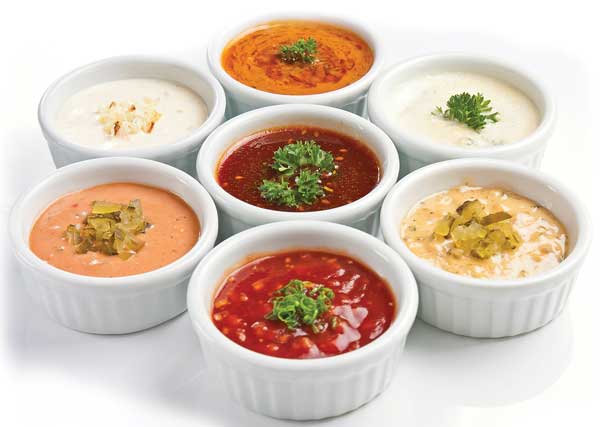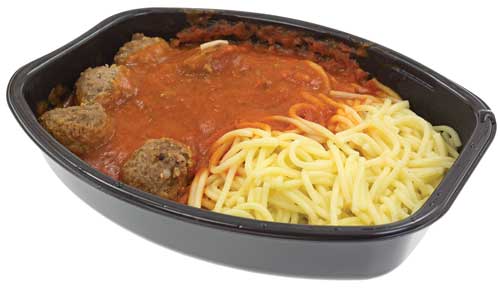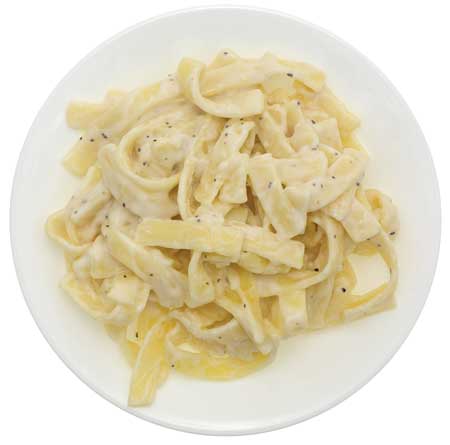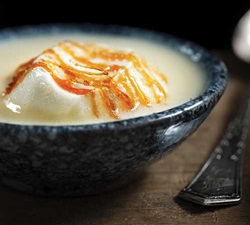Crafting Craveable Sauces
INGREDIENTS
 Don’t underestimate the culinary enhancements that a well-crafted sauce brings to entrées and side dishes. Available in a variety of styles, sauces are an integral component of many of our favorite dishes, from pasta to curries. The interest in global cuisines is playing a role in sauce product development. Some of the fastest-growing ingredients from Latin American cuisines are sauces such as green chili, chimichurri, mole, and adobo, according to research conducted by Technomic and compiled into a report from SupHerb Farms (SupHerb 2016a). Other notable sauces come from the cuisines of Italy, the Middle East, North Africa, and the Balkan region. Technomic and SupHerb Farms point to ajvar, a Serbian relish that tops side dishes; toum, a Lebanese sauce used on shawarma or as a dipping sauce; and pilacca, a fried chili pepper sauce from the Puglia region of Italy (SupHerb 2016b, SupHerb 2016c).
Don’t underestimate the culinary enhancements that a well-crafted sauce brings to entrées and side dishes. Available in a variety of styles, sauces are an integral component of many of our favorite dishes, from pasta to curries. The interest in global cuisines is playing a role in sauce product development. Some of the fastest-growing ingredients from Latin American cuisines are sauces such as green chili, chimichurri, mole, and adobo, according to research conducted by Technomic and compiled into a report from SupHerb Farms (SupHerb 2016a). Other notable sauces come from the cuisines of Italy, the Middle East, North Africa, and the Balkan region. Technomic and SupHerb Farms point to ajvar, a Serbian relish that tops side dishes; toum, a Lebanese sauce used on shawarma or as a dipping sauce; and pilacca, a fried chili pepper sauce from the Puglia region of Italy (SupHerb 2016b, SupHerb 2016c).
While some sauces are relatively quick to make and require just a few ingredients (hello, tomato and marinara sauces), many consumers want the convenience of simply opening a jar or package of a ready-to-use sauce, heating it, and incorporating it into the finished dish. The ingredients used to formulate these products are not one-size-fits-all. Plenty needs to be considered when formulating these products—everything from the processing conditions to the thickness of the finished sauce, if particulates need to be suspended, the acidity, and the shelf life. New advances in ingredients give product developers the tools they need to take sauce products to new flavor and texture levels, creating craveable sauces sure to enhance any dish.
Advances in Clean Label Starches
Starches of various types are key ingredients in many types of sauce products, where they enhance textural attributes and provide process stability. Some starch ingredients live up to consumers’ expectations of clean label and simple ingredients, but one category, that being modified starches, may raise concern among consumers who scrutinize food labels. “For years, modified starches were the workhorses of the starch world,” says Michelle Kozora, technical services director at Cargill. “Affordable, reliable, and highly functional, they were designed to stand up to the challenges of modern food processing. But today’s label-conscious consumers are increasingly attracted to simple ingredients like basic starches. In response, we’re learning how to get more from these tried-and-true ingredients.”
To accomplish this, food scientists at Cargill are taking a different look at native and functional native starches, getting back to the basics by studying and quantifying every attribute of each individual starch in the company’s portfolio, she explains. “By gaining a greater understanding of the structure and unique properties of each starch, we began to unlock their collective potential. Using this approach, we’re dramatically increasing the number of tools in our toolbox.” The insights that they have gained have changed how Cargill experts approach formulation challenges. “Now we sit down with customers to determine what specific attributes they need in a starch solution, then look at the individual characteristics of our different starches to create the right blend for their needs,” says Kozora.
Cargill recently launched a functional native starch specifically developed for use in frozen ready meal sauce applications that meets consumer demands for label-friendly ingredients. Put simply, SimPure 99560 is a blend of potato and tapioca starches that provides viscosity and freeze-thaw stability in both acidic tomato-based sauces and neutral alfredo-type sauces that are used in frozen ready meal applications.
Kozora says that the blend of starches can offer improved benefits over a single starch in the sauce applications. “As an industry, we’ve always assumed that native starches weren’t as robust as modified starches. However, since Cargill began experimenting with different starch blends from various botanical sources, we’ve found native starches can do more than we ever imagined, especially if we blend two or three together. We’re also using basic processing techniques like controlling moisture and heat to create more robust starch solutions that better withstand harsh processing conditions, yet still appear on ingredient statements as plant-sourced starches.”
 Traditional native starches formulated into sauces tend to break down and release water as the sauces are frozen, thawed, and refrozen. “They get weepy and transform a thick, creamy sauce into a gloppy mess,” says Kozora. She explains how the company’s research on the properties of various starches led to the development of SimPure 99560. “Through our scientific analysis, we found a native starch that could withstand freeze-thaw cycles remarkably well, keeping a firm hold on water through multiple cycles. While it couldn’t replace all of the functionality of a modified starch by itself, it offered a promising start. From there, we went back to our data and found another starch from a different botanical source that delivered the viscosity, texture, and shelf-life stability we needed, and after months of analytical and sensory testing, SimPure 99560 was born.”
Traditional native starches formulated into sauces tend to break down and release water as the sauces are frozen, thawed, and refrozen. “They get weepy and transform a thick, creamy sauce into a gloppy mess,” says Kozora. She explains how the company’s research on the properties of various starches led to the development of SimPure 99560. “Through our scientific analysis, we found a native starch that could withstand freeze-thaw cycles remarkably well, keeping a firm hold on water through multiple cycles. While it couldn’t replace all of the functionality of a modified starch by itself, it offered a promising start. From there, we went back to our data and found another starch from a different botanical source that delivered the viscosity, texture, and shelf-life stability we needed, and after months of analytical and sensory testing, SimPure 99560 was born.”
The SimPure 99560 ingredient can withstand up to 12 freeze-thaw cycles, putting it on par with the performance of modified starches currently in use, says Kozora. “It also delivers great texture and viscosity, holding up to the rigors of modern processing and delivering a consistent end-product in both acidic and neutral pH systems.” She adds that the scientists used real-world, customer-validated testing to confirm the performance results. “In one customer production line test, a sauce created with SimPure 99560 was held in a kettle for four hours at 180˚F, simulating a temporary production line shutdown. The results were comparable to the customer’s legacy modified starch. Another customer validated the product’s ability to withstand 12 complete freeze-thaw cycles. We’ve had customers use it with acidic tomato-based sauces and neutral alfredo-type sauce with equal success.”
The importance of the texture of sauces (and other food products) cannot be overstated, especially as manufacturers pay more attention to optimizing the textural attributes of their sauce products. “Texture is what drives our enjoyment. It’s our physical link with the foods that we eat. Whether smooth and creamy or brittle and crispy, textures tell a story and help us to connect with our food,” says Kozora.
Texture Appeal in Sauces
Developing the optimal texture of a sauce product is ongoing work. Ingredion is highlighting its innovative ingredients that bring textural enhancements and other benefits to sauce applications and meet the needs of today’s label-conscious consumer. “The latest texture trends indicate that consumers are looking for products that have a made-from-scratch appeal, which is associated with fresh and simple,” says Agnes Lapinska, senior marketing manager of performance specialties and savory at Ingredion. “Today we have ingredients and processes that allow us to manufacture meals that resemble the texture of a made-from-scratch item.” These include flours, native starches, and pulse flours.
To align with the consumer trends of simplicity and authenticity, Ingredion recently launched HOMECRAFT Create multifunctional rice and tapioca flours, which combine a clean flour label with the functionality of a modified starch, according to Lapinska. The flours are designed to provide tolerance and stability advantages in a variety of production processes, as well as other functionalities that Lapinska notes. “HOMECRAFT Create multifunctional rice and tapioca flours provide exceptional flavor release and enhanced creamy textures that allow food manufacturers to reduce fat content and improve nutrition profiles. The range of flours can also deliver comparable or even higher viscosity than clean label starches in some applications, offering opportunities for cost savings.” Moreover, the ingredients are gluten-free and are not genetically modified.
Ingredion also offers ingredients for sauce applications from its line of NOVATION functional native starches, which were developed to replace modified starches in sauce applications, says Lapinska. “Since the manufacturing condition of sauces can vary, our NOVATION functional native starch product line covers a breadth of manufacturing conditions.”
 Manufacturers will face different processing and formulation challenges depending on the type of sauce they are making. “For example, for high-fat sauces such as alfredo it is important to maintain delicate flavor and creaminess of the sauce; in this case we can use our line of HOMECRAFT Create multifunctional rice starches, which provide an excellent creaminess along with clean flavor profile,” says Lapinska. “For acidic sauces such as tomato sauce, the processing stability is very important as typically these sauces are low in pH (have high acidity) and can be processed using harsh processing conditions. For those specific sauces, we suggest our NOVATION Endura 0100 functional native starches, which were developed to withstand low acid and intensive processing conditions.”
Manufacturers will face different processing and formulation challenges depending on the type of sauce they are making. “For example, for high-fat sauces such as alfredo it is important to maintain delicate flavor and creaminess of the sauce; in this case we can use our line of HOMECRAFT Create multifunctional rice starches, which provide an excellent creaminess along with clean flavor profile,” says Lapinska. “For acidic sauces such as tomato sauce, the processing stability is very important as typically these sauces are low in pH (have high acidity) and can be processed using harsh processing conditions. For those specific sauces, we suggest our NOVATION Endura 0100 functional native starches, which were developed to withstand low acid and intensive processing conditions.”
Pulse flours such as HOMECRAFT Pulse flours are clean label ingredient options that allow manufacturers to replace wheat flours and achieve similar textural properties without any gluten, says Lapinska. “Because our HOMECRAFT Pulse flours are minimally processed, there could be stability challenges when using them in high moisture systems such as sauces. However, from our experience we know that HOMECRAFT Pulse flours can be used in combination with the NOVATION functional native starch product line to replace wheat flour and give specific homemade product characteristics with increased stability.” The pulse flours are derived from sources like lentil and faba.
The Potential of Dairy Ingredients
Of the five mother sauces of French cuisine (béchamel, velouté, espagnole, tomato, and hollandaise), four have a shared commonality—a dairy component. Milk, butter, and cheese give sauces indulgent flavor and texture, and in turn, these dairy-based sauces are a rich accompaniment to pasta, vegetables, and meat. In addition to milk, butter, and cheese, other dairy ingredients such as milk protein isolates and concentrates, micellar casein concentrates, whey protein isolates and concentrates, permeates, and fermented products like yogurt are used to meet functional, flavor, and nutritional needs, says Kara McDonald, vice president of global marketing communications at U.S. Dairy Export Council. The organization produces product concept formulations, and McDonald offered up a few sauce formulations that feature dairy ingredients: Asian dipping sauce with whey permeates, mango chutney cottage cheese dip with cottage cheese and milk protein isolate, and spicy chipotle ranch with whole milk yogurt.
 Milk proteins (concentrates and isolates) are high-quality proteins found in milk that are typically manufactured through water filtration to remove lactose and soluble minerals while retaining the protein. Milk proteins range from 42%–90% protein. McDonald says that the ones in the range of 42%–50% protein are used as ingredients in sauce applications where they provide water binding, thickening, emulsification, and heat stability. “Nutritionally, milk proteins contribute high-quality protein and calcium, magnesium, and phosphorus to formulations. Proper agitation in warm water 50°C/122°F for 45–60 minutes prior to further processing allows for a complete hydration of the protein, which ensures the functionality of the protein in the finished application.”
Milk proteins (concentrates and isolates) are high-quality proteins found in milk that are typically manufactured through water filtration to remove lactose and soluble minerals while retaining the protein. Milk proteins range from 42%–90% protein. McDonald says that the ones in the range of 42%–50% protein are used as ingredients in sauce applications where they provide water binding, thickening, emulsification, and heat stability. “Nutritionally, milk proteins contribute high-quality protein and calcium, magnesium, and phosphorus to formulations. Proper agitation in warm water 50°C/122°F for 45–60 minutes prior to further processing allows for a complete hydration of the protein, which ensures the functionality of the protein in the finished application.”
Like milk protein concentrates and milk protein isolates, micellar casein concentrate is produced from microfiltration of milk. The casein to total protein ratio can vary from 80:20 up to 95:5, with typical micellar casein having a ratio of 92:8, says McDonald. Lactose and most of the whey proteins are removed during the production of milk protein concentrate, making it heat stable at temperatures greater than 80°C/176°F and ideal for protein-fortified sauces that are thermally processed for shelf stability, she adds.
The whey protein component of milk is also processed into functional ingredients. Whey protein, which makes up 20% of the total protein in milk (caseins make up 80%), can be isolated and concentrated into whey protein concentrate, whey protein isolate, or milk-derived whey protein (milk whey protein), says McDonald. These ingredients provide gelation, water binding, foaming, viscosity, and/or emulsification functions to products, and remain soluble in water over a pH range of 2–9.
Another category of dairy ingredients for use in sauces that McDonald points to is milk and whey permeate, which are listed as dairy product solids. They are coproducts produced while concentrating the protein during the water filtration process. Permeates have good solubility and contain higher concentrations of calcium, potassium, and magnesium, and this higher mineral content allows permeates to contribute salty taste to foods without increasing the sodium content of the finished products, explains McDonald. “As consumers look to reduce their sodium intake, dairy permeate ingredients show great promise as a tasteful alternative which can be used to lower the final sodium content of many sauces.”
Fermented foods and flavors are popular, and many new products that feature these are available. “As consumers experiment with fermented flavors, yogurt as an ingredient could be an interesting option,” says McDonald. As an ingredient, yogurt can add creaminess, viscosity, and a unique flavor and contribute protein and minerals to many sauces, dressings, and dips, she adds. Standard yogurts and dehydrated yogurt powders (made from cultured milk and dried into powder after fermentation) can be used.
Herb Pastes Add Freshness, Global Appeal
As a grower, processor, and supplier of fresh and IQF herbs and IQF specialty vegetables, SupHerb Farms specializes in helping product developers use these delicious and fragrant plants in a variety of sauce applications. These herb ingredients—which undergo minimal processing and contain no additives—are clean label, have fresh appearance and flavor, and give finished products bold flavors.
Anna Lewis, director of quality and research and development at SupHerb Farms, says these trends are having a major impact on product development efforts in the sauce category and can help drive innovation and attract customers. “For our foodservice customers, we are seeing more companies looking at options for improving consistency of items that they currently make back of house at their restaurants.” She adds that there are also foodservice customers who run multiple locations and who need to produce food items with consistent quality and appearance across those locations. “SupHerb Farms is able to process these products in a scaled-up version that still provides the essence of the original recipe, without concerns on variation between store locations.” Consumers are looking for ways to have restaurant-like experiences at home, and this factors into food manufacturers’ product development efforts. Lewis says that these consumers want companies to provide easy-to-use, great-tasting products that they have come to enjoy from their restaurant experiences. “These products can be provided in all manner of packaging, but they are wanting to feel like the product is fresh and be able to understand the ingredient statement.”
The strong interest in global cuisine is also influencing product development efforts. “The increased knowledge base of consumers has really expanded the product offerings available in the marketplace,” says Lewis. “Customers are no longer wanting a generic cuisine from a country. They now are looking at specific regions and what those regional variations provide in flavor and experience.” Nowhere is this interest in global cuisine stronger than with the consumers of the generation known as Gen Z. (Sources define it differently, but members of the generation are those born in the mid-1990s to the early 2000s.) More than half (59%) of Gen Z consumers said that they like to try new flavors of food from time to time, and 31% want restaurants to offer more global food and beverage items (SupHerb 2016d). Sauces play an important role in satisfying these consumers’ desires for more global foods. The report suggests adding global sauces on the side to encourage sampling, experimenting, and customizing, and reminds chefs that sauces are a great application that can incorporate bold and global flavors that Gen Z consumers want when dining out.
 The interest in global cuisines by Gen Z and members of generations across the board along with the other trends Lewis mentioned have sparked the development of a line of global cuisine-inspired culinary pastes and blends that showcase some of the company’s herbs and other ingredients. The Fusions Culinary Pastes and Blends contain ingredients from and capture the flavors of cuisines from regions across five continents and can be used to formulate sauces to use as toppings for meat, seafood, pasta, grains, and vegetables; for dipping; and for formulating stews, curries, and other similar entrées. Some of the standouts from the line used to formulate flavorful sauces are Thai Green Curry, Thai Red Curry, Chimichurri, Filipino Adobo, and Indian Masala. There’s also S’chug, a Middle Eastern hot sauce made from jalapenos, garlic, and herbs, and Chermoula, a Moroccan sauce that combines cilantro, parsley, and garlic for mild tanginess and a slight kick of heat. Pastes and blends such as Moroccan Harissa, Ginger Cilantro Sesame, Creole, and Indonesian Style Chili Paste can serve as a foundation for sauces and marinades to use in pasta entrées, grain dishes, and meat and seafood applications. A few of Lewis’ personal favorites for formulating further processed sauces are S’chug, Aji Pesto, Moroccan Harissa, and Mexican Ancho Chile with Lime.
The interest in global cuisines by Gen Z and members of generations across the board along with the other trends Lewis mentioned have sparked the development of a line of global cuisine-inspired culinary pastes and blends that showcase some of the company’s herbs and other ingredients. The Fusions Culinary Pastes and Blends contain ingredients from and capture the flavors of cuisines from regions across five continents and can be used to formulate sauces to use as toppings for meat, seafood, pasta, grains, and vegetables; for dipping; and for formulating stews, curries, and other similar entrées. Some of the standouts from the line used to formulate flavorful sauces are Thai Green Curry, Thai Red Curry, Chimichurri, Filipino Adobo, and Indian Masala. There’s also S’chug, a Middle Eastern hot sauce made from jalapenos, garlic, and herbs, and Chermoula, a Moroccan sauce that combines cilantro, parsley, and garlic for mild tanginess and a slight kick of heat. Pastes and blends such as Moroccan Harissa, Ginger Cilantro Sesame, Creole, and Indonesian Style Chili Paste can serve as a foundation for sauces and marinades to use in pasta entrées, grain dishes, and meat and seafood applications. A few of Lewis’ personal favorites for formulating further processed sauces are S’chug, Aji Pesto, Moroccan Harissa, and Mexican Ancho Chile with Lime.
Next month’s Ingredients section will provide a preview of some of the ingredient suppliers exhibiting at IFT18 in Chicago (expo dates: July 16–18).
www.ift.org
Members Only: Read more about ingredients used to formulate sauces and sauce products at ift.org. Type the keywords into the search box at the upper right side of the home page.
 Karen Nachay,
Karen Nachay,
Senior Associate Editor
[email protected]
References
SupHerb. 2016a. Trend Outlook: Latin Cuisines. SupHerb Farms, Turlock, Calif. supherbfarms.com.
SupHerb. 2016b. Trend Outlook: Middle Eastern, North African and Balkan Cuisines.
SupHerb. 2016c. Trending Now: The “New” Italian.
SupHerb. 2016d. Trend Outlook: Generation Z.

 The pivotal ingredient in hollandaise sauce is egg yolk, which emulsifies the other ingredients—water, butter, and fresh lemon juice. Eggs and egg ingredients play important roles in both savory and sweet sauces, where they emulsify ingredients, thicken sauces, add flavor, or improve mouthfeel. The American Egg Board features several sauce formulations such as crème anglaise, aioli sauce, hollandaise sauce, mousseline sauce, and raspberry balsamic curd that use various liquid and dried egg ingredients. For food manufacturers and foodservice operators, ingredients like dried whole eggs, dried egg yolks and whites, shelf-stable liquid eggs, liquid whole eggs, and liquid egg yolks and whites can provide cost savings, ease of use, and consistency from batch to batch. Suppliers such as Rembrandt Foods and NestFresh Eggs can work with manufacturers to determine the optimal egg yolk or whole egg ingredient to use in creamy sauce applications.
The pivotal ingredient in hollandaise sauce is egg yolk, which emulsifies the other ingredients—water, butter, and fresh lemon juice. Eggs and egg ingredients play important roles in both savory and sweet sauces, where they emulsify ingredients, thicken sauces, add flavor, or improve mouthfeel. The American Egg Board features several sauce formulations such as crème anglaise, aioli sauce, hollandaise sauce, mousseline sauce, and raspberry balsamic curd that use various liquid and dried egg ingredients. For food manufacturers and foodservice operators, ingredients like dried whole eggs, dried egg yolks and whites, shelf-stable liquid eggs, liquid whole eggs, and liquid egg yolks and whites can provide cost savings, ease of use, and consistency from batch to batch. Suppliers such as Rembrandt Foods and NestFresh Eggs can work with manufacturers to determine the optimal egg yolk or whole egg ingredient to use in creamy sauce applications.